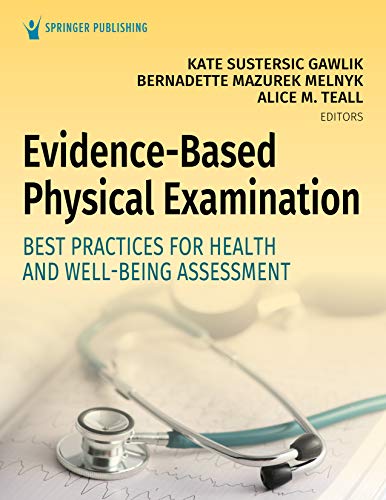Evidence-Based Physical Examination Best Practices for Health & Well-Being Assessment 1st Edition Test Bank
Digital item No Waiting Time Instant DownloadChapters: 29Format: PDFISBN-13: 978-0826164537ISBN-10: 0826164536Publisher: Springer Publishing CompanyAuthors: Kate Gawlik, Bernadette Melnyk, Alice Teall
In Stock
Original price was: $55.00.$23.50Current price is: $23.50.
Evidence-Based Physical Examination Best Practices for Health & Well-Being Assessment 1st Edition Test Bank
Evidence-Based Physical Examination: Best Practices for Health & Well-Being Assessment, 1st Edition – Test Bank
Overview: The test bank for “Evidence-Based Physical Examination: Best Practices for Health & Well-Being Assessment,” 1st Edition, focuses on the application of evidence-based practices in conducting physical examinations. This resource is essential for healthcare professionals and students who aim to enhance their skills in performing thorough, accurate, and evidence-based physical assessments. It provides a range of questions designed to assess knowledge and application of best practices in physical examination and patient assessment.
Key Features:
- Comprehensive Coverage:
- The test bank includes questions that span all chapters of the textbook, covering various aspects of physical examination techniques, assessment strategies, and best practices. It addresses foundational principles as well as advanced topics in physical examination.
- Variety of Question Formats:
- The test bank features multiple-choice questions, true/false questions, fill-in-the-blank questions, and case studies. This variety allows for a thorough assessment of both theoretical knowledge and practical application skills.
- Evidence-Based Focus:
- Emphasizing evidence-based practices, the test bank includes questions that test knowledge of current research, guidelines, and best practices in physical examination. This focus ensures that students and professionals are aligned with the latest standards in patient assessment.
- Clinical Scenarios:
- Many questions are based on clinical scenarios that require the application of physical examination techniques to real-world situations. This approach enhances problem-solving and critical thinking skills.
- Alignment with Learning Objectives:
- Each question is designed to align with the learning objectives outlined in the textbook. This ensures that the test bank provides relevant assessments that reflect key concepts and skills needed for effective physical examination.
- Critical Thinking Emphasis:
- The questions are crafted to promote critical thinking, requiring students to analyze patient information, apply examination techniques, and make informed decisions based on evidence.
- Customizable Assessments:
- Educators can use the test bank to create customized quizzes, exams, and practice tests tailored to specific course requirements. This flexibility supports targeted assessment and feedback.
Content Breakdown:
- Fundamentals of Physical Examination:
- Questions cover the basics of physical examination, including preparation, patient communication, and documentation. Understanding these fundamentals is essential for conducting effective assessments.
- System-Based Assessment:
- The test bank includes questions on assessing different body systems, such as cardiovascular, respiratory, gastrointestinal, musculoskeletal, and neurological systems. Students are tested on techniques, findings, and interpretations specific to each system.
- Evidence-Based Techniques:
- Questions focus on evidence-based techniques for conducting physical examinations, including best practices for performing and interpreting various assessment procedures. This includes guidelines for accurate and reliable assessments.
- Patient Safety and Comfort:
- The test bank addresses strategies for ensuring patient safety and comfort during physical examinations. This includes questions on infection control, patient positioning, and managing patient anxiety.
- Documentation and Reporting:
- Questions cover best practices for documenting and reporting physical examination findings. This includes accurate recording of assessment data, communication of findings, and adherence to legal and ethical standards.
- Clinical Decision Making:
- The test bank includes questions that test students’ ability to make clinical decisions based on physical examination findings. This includes prioritizing patient needs, formulating differential diagnoses, and planning further investigations or interventions.
- Cultural Competence:
- Questions focus on cultural competence in physical examination, emphasizing the importance of understanding and respecting cultural differences in patient assessment and communication.
- Integration of Technology:
- The test bank includes questions on the use of technology in physical examination, such as electronic health records and diagnostic tools. Understanding how to integrate technology into assessments is essential for modern clinical practice.
Practical Applications:
- For Students:
- The test bank is a valuable resource for students in health-related programs, helping them to prepare for exams and develop a thorough understanding of evidence-based physical examination practices. It aids in reinforcing knowledge and applying concepts to clinical scenarios.
- For Educators:
- Instructors can use the test bank to create assessments that align with course objectives, providing a structured way to evaluate students’ understanding and readiness for clinical practice.
- For Practicing Clinicians:
- Healthcare professionals can use the test bank to refresh their knowledge, stay updated on best practices, and prepare for continuing education or certification exams. It serves as a tool for reviewing and enhancing physical examination skills.
Conclusion:
The “Evidence-Based Physical Examination: Best Practices for Health & Well-Being Assessment, 1st Edition” test bank is an essential resource for students, educators, and practicing clinicians in the field of healthcare. It offers a comprehensive assessment of key concepts, clinical scenarios, and practical skills related to physical examination, with a strong emphasis on evidence-based practice. By providing a variety of question formats and focusing on real-world applications, this test bank helps ensure that individuals are well-prepared for effective and accurate patient assessment in clinical settings.


Reviews
There are no reviews yet.